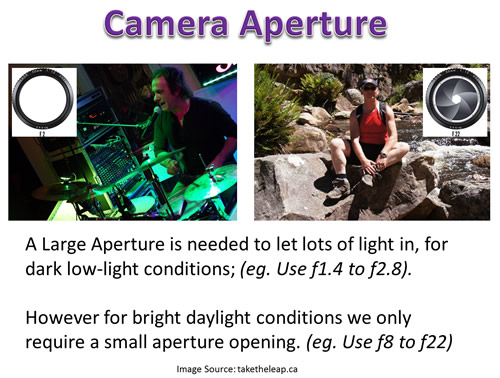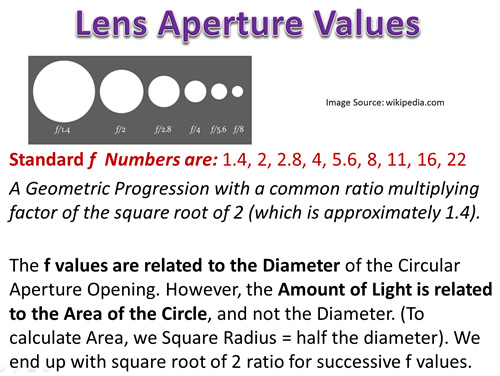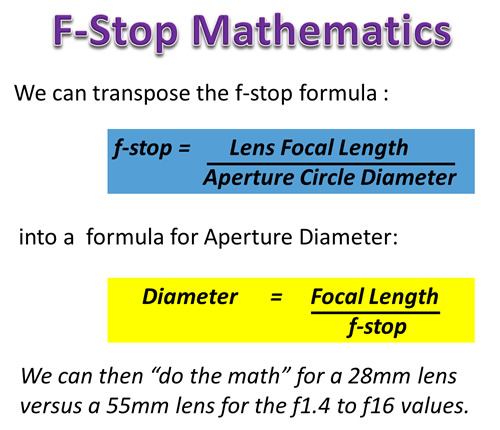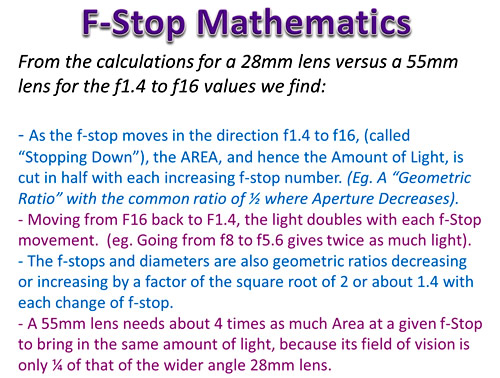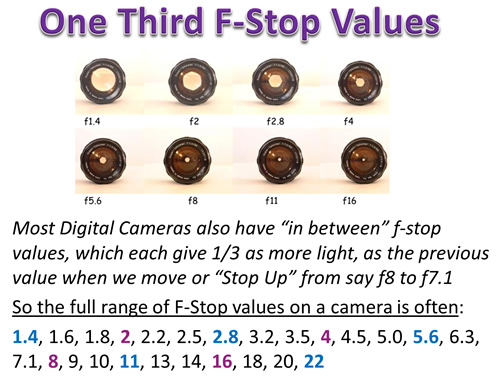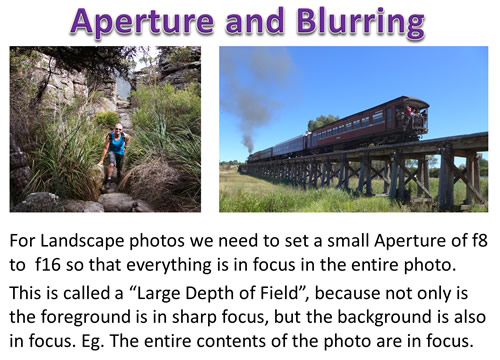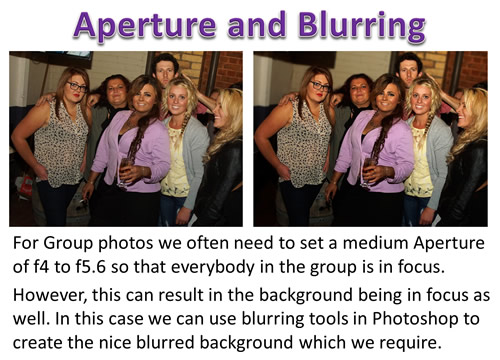Aperture is one of the key variables in Digital Photography. The other two are ISO Light Sensitivity and Shutter Speed.
It is a good idea to read our previous article on “How To Do Camera Settings” before working through this Aperture Article.
You can access this article at the following link:
An understanding of Aperture is critically important to isolate subjects in portraits and get full detail in Landscape pictures.
The Aperture Scale consists of a seemingly odd set of decimal and whole numbers, and getting your head around these values is not at all easy for Beginner Photographers.
In this article we examine Aperture in detail, and mathematically explain where the Aperture “f-numbers” come from. The mathematics might be challenging for some people, but do not worry too much about the detail if it is challenging for you.
The main thing we need to understand as Photographers is how the “f-stop” number values relate to the amount of light made available for our image, and how the background can be deliberately blurred using Aperture settings.
Definition of Aperture
Camera Aperture basically imitates the function of the human eye.
In dark conditions we require more light entering our eyes and camera, but in bright light we need far less light.
Our eyes adjust to these conditions using our “pupils”, (the central dark circles inside our eyes).
A camera mimics the action of our pupils using a setup that creates various size circles; and we call this camera function “Aperture”.
Using Camera Aperture Values
We go to detail about this later in this article, but just as a starter, here are a couple of examples where we use different sized Apertures, which mimic the function of the human eye.
Lens Aperture Values
The Aperture function is performed in the Lens of the camera, and not in the Digital Camera Body. (The “Lens” is the cylindrical barrel on the front of the camera, and the “Body” is the back part of the camera with all the buttons and dials on it.
Each lens we mount onto a DSLR camera has its own Aperture System, and as we will see later on, different sized lenses need to have their own particular Aperture systems.
Lens Apertures are specified using f Numbers which are called “f-stops”.
These numbers make little sense at all when we first look at them, as they are what seems to be some weird random collection of decimal and whole number values.
A first look at these strange f-numbers reveals that there are doubling patterns in the list of numbers from f1.4 to f22.
Another very confusing aspect of these f-numbers is that as they go up in value, the size of the circular Aperture openings actually goes down in value, and the cicular “Aperture” openings become progressively smaller.
In fact each circle becomes exactly half the size of the one before it.
This is indeed very confusing, as the smallest number 1.4 represents a large fully open camera lens letting in lots of light, but the largest number at f22 represents a tiny cicular opening in the lens which is not letting much light in.
Mathematical Patterns
The standard f-numbers are: 1.4, 2, 2.8, 4, 5.6, 8, 11, 16, 22 .
We can always form the next number in the pattern by multiplying by 1.4, which is the square root of 2 as a rounded off decimal value.
1.4 x 1.4 = 1.96 = 2
2 x 1.4 = 2.8
2.8 x 1.4 = 3.92 = 4
4 x 1.4 = 5.6
5.6 x 1.4 = 7.84 = 8
and so on.
In the f-numbers we have a sequence of numbers, where we always multiply by a common value of 1.4 to generate the next number.
In mathematics this is called a “Geometric Sequence” or a “Geometric Progression”
The common multiplying value, in this case 1.4, is called the “Geometric Ratio”.
The 1.4 (Square Root of 2) value results because we are dealing with Circles when we are doing Apertures.
If we want to make a Circle twice as big, it turns out that we need to increase its Radius by a factor of Square Root of 2, which in decimal is 1.4.
So if you are wondering where the 1.4 multiplying factor comes from, it is all due to the way the area of circles is doubled.
The f-numbers sequence is set up so that in real terms the amount of light due to the circular opening halves as we move up through the f-numbers.
F-Stop Formula
We are nearly through the Mathematics of Aperture.
As a Photographer you do not need to memorise all this mathematics, you simply need to understand the consequences in relation to light entering your camera.
There is a Mathematical Formula for f-stop which relates the 1.4,2,2.8,4,5.6, etc values to the actual Aperture Circle Diameter, and the size of the Lens you are using.
Aperture is not just related to how wide we make our circular opening, (the “Diameter”), but it is also related to the size of the Lens we are using which is specified as the Lens “Focal Length”.
We will confine our discussion to fixed size lenses, called “Prime Lenses”, and talk about “Zoom” lenses later on.
A 28mm Lens is a short lens, which gives a very wide angle of viewing.
A 50mm or 55mm lens is a standard size which is supposed to be a lot like the angle of viewing, or field of vision that is in focus when we are looking at something with human eyes.
A 200mm lens is a “Telephoto” type lens which will make distant objects look a lot closer, just like a set of Binoculars would.
The 28mm lens with its wide view lets in the most light, and the 200mm long lens lets in the least light.
Thinks of it like being at the Beach.
If you were at the beach looking at the whole scene there would be lots of light from the sun, and its reflection on the water. This is what a 28mm lens gives you, a nice wide picture where you can see everything, and there is plenty of light.
If you were just looking at some children building a sand castle, then this is the type of view from a 50mm lens.
If you were using a 200mm lens to look at some guys fishing in a boat off the shore, then this is a zoomed in type situation, and you only get the light from the boat and people, and not lots of light like when you are looking at the whole beach scene.
This is the reason why we need to take “Focal Length” or lens size into account. To get the same f-stop amount of light, we actually need different sized circular openings on different sized lenses.
In the example shown below, the two lenses are set to the exact same f-stop, so that the exact same amount of light can reach the interanl camera sensor.
However, to get the exact same amount of light into the camera body, we need to use a much larger physical Aperture opening on the long 200mm lens.
Video About Aperture
By now you might be totally overwhelmed by all of this Mathematics, but do not worry about it, because the main thing you need to understand is that Aperture changes the circular lens opening to let in more light or less light.
If we adjust our current F-Number UP to the next F-Number we HALVE the light.
If we adjust our F-Number DOWN to the previous F-Number we DOUBLE the light.
We need to adjust the light to get a picture that is not overly bright and washed out, and not overly dim and too dark to see its contents.
The following 15 minute video explains what we have covered so far.
Some Final Mathematics
Here is one last set of Mathematical calculations to show how Aperture works for different sized lenses.
We will work backwards to find the actual mm diameters of the circlular openings we would need in two different lenses to get the same amount of light which would mean we had the same f-number or “f-stop” set on each of the lenses.
To find the Diameters required, we rearrange our previous f-stop formula as follows:
Once we have the diameter required, we can halve it to get the circle radius and then calculate the actual Area of the circular opening we would need in the lens to create given f-stop amounts of light.
These calculations are shown below:
The above calculations were obtained from an excellent article on Camera Mathematics from Mr Martin which can be viewed in full at the following link:
Mr Martin Mathematics of Photography Article
By examinng the results of the above calculations we can see the following patterns and results:
One Third F-Stops
Finally just to add another layer of complexity to everything, if you check the Aperture f-number values on your actual camera, it is likely that there will be more than just the standard values we have been discussing:
1.4, 2, 2.8, 4, 5.6, 8, 11, 16, 22
Your camera (thanks to the wonders of modern technology) will have the standard values, plus a whole lot of extra in between values.
These values allow you to change your Aperture light up or down by 1/3. This way you can open the Aperture up to 1 and 1/3, then to 1 and 2/3, and then up to Double the amount of light.
Your camera will possibly have this full set of one third f-stops, resulting in a sequence like this:
1.4, 1.6, 1.8, 2, 2.2, 2.5, 2.8, 3.2, 3.5, 4, 4.5, 5.0, 5.6, 6.3, 7.1, 8, 9, 10, 11, 13, 14, 16, 18, 20, 22
Aperture Blades
Anyone who has ever tried to draw a perfect circle freehand knows exactly how hard it is to do.
It is also very difficult to mechanically make circles of different sizes, and often the Aperture openings are not actually circular, but might be Pentagons, octagons, or other multisided geometries.
The lens uses a series of adjustable “Aperture Blades” to make the best circles it can.
Basicially the more you pay, the more blades in the system, and the better the circles will be.
Two lenses sitting side by side might have drastically different prices, because one of them has a many blades quality system inside it.
If you have a cheap lens with not many blades, blurred lights in the background will not be round, and you may also get some slightly dark tinges in the four corners of your photos.
Aperture and Zoom Lenses
Most people have an adjustable zoom lens on their camera, which can do wide angle shots, through to zoomed in telephoto pictures.
As we saw previously, the field of vision narrows as we increase lens focal length, and so it is tricky for the Aperture system to continually adjust to different focal lengths as you zoom in and out.
This is why there are cheap and very expensive zoom lenses.
A Cheap Zoom Lens for $300 might only allow Apertures from f4 to f8 and the picture will darken as you zoom in.
An expensive f2.8 Zoom for $1500 to $15000 will allow you to use all Apertures no matter how far you are zoomed in or out.
Those giant white “bazooka” looking lenses you see at sports events can cost anywhere from $5000 to $25000 !
Aperture and Blurring
Well that is all the Mathematics and Technical stuff done with, and now we can talk about actually taking some photos!
A really nice side effect of using wide open Apertures is that we end up with our subject at the front of the picture crisply in focus, and the background we are not interested in all blurred out for us.
However, if we want to see our whole photo in clear focus, like on a landscape shot, we need to do the opposite and set a very narrow (high f-number) Aperture.
Group Shots and Blurring
However, with taking “Group Shots” of people we run into a problem.
If we use f1.4, or f2, or f2.8 to get nice background blurring, we will find that people in the back row of the group will be blurred out of focus.
To get the whole group in focus we typically need to use an Aperture of f4 or f5.6, which will make sure everybody in the group is in focus.
However, the background we are not interested in will also be in focus and clearly visible.
The way aorund this problem is to use Blurring Tools in Photoshop, as has been done below.
Aperture and Sunsets
Sunset Photos can also be interesting for setting up the Aperture correctly.
We might use a really narrow Aperture like for a landscape, and our image will be too dark; or we might use a wide open Aperture and have our photos turn out too bright and look like daylight.
The best Aperture to use is between f8 and f11, as shown below in these great photos taken by our friend Nicole Cooper.
The following page has thirty great tips for taking good sunset photos:
30 Tips for Taking Sunset Photos
Video About Aperture and People Shots
Finally here is a two part video totalling around 25 minutes all about how to set your Aperture when doing Night Club Photography, or really any Photos at Events like Birthdays, Baptisms, Parties, and so on.
Here Part 2 of the above Video.
Sony Video About Aperture
Here is an excellent video all about Setting Aperture on Sony Alpha Cameras.
References
Click the following links for more articles on the web about Aperture.
Very Technical Maths Explanation of Aperture
Mathematical Explanation of F-Stops
Related Items
For more great articles about How to Do Digital Photography, see our “How To” page at the following link:
How To Articles by Photos By Passy
Subscribe
If you enjoy visiting Photos By Passy, why not get a free subscription to the website.
You can then receive notifications of new items and updates directly to your email address.
Go to the subscribe area on the left hand sidebar, (or down the bottom of the page if using a mobile phone), fill in your email address and then click the “Subscribe” button.
Enjoy,
Passy



